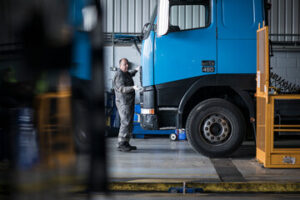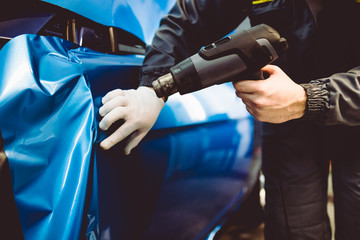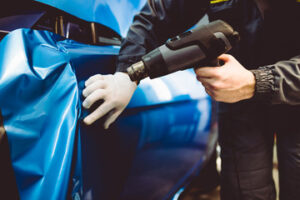Truck Detailing Perth goes far beyond cleaning. It also protects the surface with protectants to enhance shine and prevent damage from exposure to outdoor elements.
Much like a car, the detailer starts with rinsing and snow foaming to remove as much dirt as possible before washing. This avoids causing microscopic scratches that will deteriorate the paint over time.

A vehicle’s exterior is a magnet for road grime, dirt, debris and pollen. Regular truck detailing keeps the paint and other body panels free of such damage. Once the body panel surface is clean and the paint is protected with a wax, your truck will look new for years to come.
A detailer will first start with a thorough washing of the entire surface. A good quality detergent and a microfiber wash mitt will be used to reduce the risk of scratching. Once the dirt is removed, a clay bar may be used to remove stubborn stuck on contaminants like bug guts and tar. Then, a high performance wax will be applied to the entire vehicle. Waxing not only improves the shine and luster of your paint, but it also adds a layer of protection against harmful UV rays and harsh chemicals.
Then, the rubber and vinyl parts of your vehicle will be treated with protectants. This will typically include a dab of protectant on a clean cloth and then wiping down all the rubber and vinyl parts of your vehicle including door and window moldings, trim, mirrors and even the tires. Once the protectant dries, it will leave behind a haze that can be buffed away with a prep spray or IPA panel wipe.
Lastly, the rims and tires will be cleaned to make sure that any brake dust or other harmful substance is not left behind. This is important because it can lead to corrosion of the metal rims and tires if not removed regularly.
There are a few things that are different about detailing a truck versus a car, but most of the time the process is the same. Just be careful to work indoors or in the shade, and only use products that are recommended for your specific type of vehicle. If you’re unsure of what products are safe and effective for your vehicle, consult with a professional. They will be able to guide you through the process safely and effectively.
The interior of a truck is just as important to detail as the exterior. Over time, a truck can accumulate lots of dirt and grime. Having it regularly detailed by a professional ensures that the inside is clean and free of contaminants. This can also help increase the resale value of the vehicle.
A detailer will shampoo all of the carpets and seats, remove the mats and vacuum the cab. They will also clean the cup holders, storage bins and glove boxes. They will then apply a protective wax to the interior of the truck. This will keep the interior looking new and will protect it from harmful UV rays.
One of the biggest challenges in detailing a truck is getting rid of stubborn grease spots. Some of them require a chemical solution, while others need to be scrubbed with a brush and a degreasing agent. The detailer should use care to avoid transferring these contaminants to areas that aren’t greased up.
After removing the dirt and grime, a professional will inspect the vehicle for any scratches or blemishes. They can then decide if the paint is dull and needs to be corrected. This may include using a clay bar to remove contaminants, buffing with a machine glaze, or even sandpaper and bodywork.
While there is no way to stop the wear and tear of driving a truck, a thorough cleaning on a regular basis can prolong its life and keep it looking like new. Regular detailing can also reduce the need for expensive repairs and maintenance.
The cost of a professional detailing service can vary depending on the size and condition of the truck, as well as the location of the detailing shop. It’s also important to consider the weather conditions in your area. If your area has a lot of snow or dust, you’ll need to detail the car more frequently than if it was located in a sunny state. Also, be sure to factor in the cost of the detailing products you’ll need for each job. Some products are reusable, while others need to be purchased each time.
The engine bay is one of the most important parts of a truck detailing project. Not only does it look good, but it can also help identify problems and prevent costly repairs. If the hood is left open and dirty, it can allow water and debris to build up and cause problems in your engine. This can damage sensors, hoses, and wires. Professional detailing will ensure that the hood is properly cleaned and sealed to protect these delicate components.
The first step is to spray a degreasing solution across the engine bay and flip up the hood. This can be done with a high-quality nozzle or even just your garden hose. You may need to use a brush or rag to agitate the visible buildups. If you have a hard time getting to all of the crevices, a small brush like an EZ Detail brush can be very helpful. These brushes are covered in soft, chemical-resistant nylon nylex bristles and are very flexible to get into tight spaces.
Next, you should wipe down all the surfaces of the engine and bay with a high-quality microfiber towel. This will remove any remaining dirt and grease. Once the engine is dry, it’s a good idea to coat the rubber and vinyl parts with a product such as 303 Aerospace Protectant. This will help prevent the rubber hoses, wires, and plastic shields from becoming brittle and cracking.
When you take your truck out for shows or when you’re hanging out with your car guy/girlfriends, the clean engine will stand out from those that haven’t taken the time to get theirs detailed. If you want to take your detailing a little further, you can polish aluminum parts and paint key parts in bright colors. Just make sure to cover up anything that isn’t water-friendly.
While you can wash and degrease your own engine, it’s best to leave this job to a professional who has experience with this process. Be sure to ask them how they will insulate and cover up any sensitive areas before washing, as well as at what pressure they will be using their steam jet.
If you want to maximize the value of your truck detailing project, consider using protectants to enhance shine and reflectivity, reduce damage from oxidation and extend the life of the paint job. Trucks get a lot of wear and tear, particularly from hauling heavy loads over long distances. Regular detailing helps prevent scratches, dirt and grime buildup. Additionally, detailing helps maintain the resale value of your vehicle, increasing its saleability should you decide to sell it in the future.
Whether you operate as a mobile detailer or in a brick-and-mortar location, your prices will vary depending on the service you provide, your reputation, and the size and quality of the vehicles you work on. In addition, you’ll need to consider the cost of equipment and materials such as cleaning products. If you’re unsure of how much to charge for your services, consider the average hourly rate for a professional car detailer in your area.
The amount of time you spend working on each vehicle also affects your pricing. For example, a vehicle with tough staining may require more time to clean than a vehicle with simple exterior stains. You may also need to use specialized tools like clay bars, which are expensive and time-consuming. In these cases, your prices will be higher than those for a simpler wash.
Other variables that affect price include the amount of water you need to use to wash a vehicle. Many state regulations restrict the amount of water that can be used during a detailing session, so you’ll have to invest in a greywater system or find an alternative method to recycle your water. Some detailers collect and reuse the water they use for washing, which can help cut your costs.
To avoid overspending, make sure you factor in all your business expenses when determining your pricing. These include labor, materials and taxes. Labor costs are the most significant expense for most detailers, so be sure to include an accurate hourly rate when calculating your pricing. You’ll also need to factor in any supplies you need to complete the job, such as all-purpose cleaners, leather conditioner and waxes or sealants.


 Branding
Branding